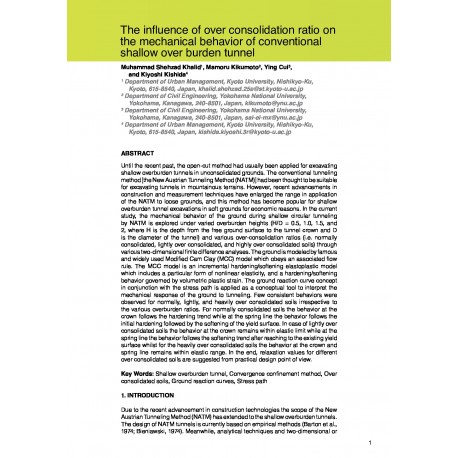Cart
0
0
No document
0,00 €
Total
Document successfully added to your shopping cart
Quantity
Total
There are 0 items in your cart.
There is 1 item in your cart.
Total documents
Total shipping
To be determined
Total
Search & filter
Search for a publication
Search & filter

The influence of over consolidation ratio on the mechanical behavior of conventional shallow over burden tunnel
2094_the_influence_of_over_conso
Y. Cui / M. S. Khalid / M. Kikumoto / Kiyoshi Kishida
Until the recent past, the open-cut method had usually been applied for excavating shallow overburden tunnels in unconsolidated grounds. The conventional tunneling method [the New Austrian Tunneling Method (NATM)] had been thought to be suitable for excavating tunnels in mountainous terrains. However, recent advancements in construction and measurement techniques have enlarged the range in application of the NATM to loose grounds, and this method has become popular for shallow overburden tunnel excavations in soft grounds for economic reasons. In the current study, the mechanical behavior of the ground during shallow circular tunneling by NATM is explored under varied overburden heights (H/D = 0.5, 1.0, 1.5, and 2, where H is the depth from the free ground surface to the tunnel crown and D is the diameter of the tunnel) and various over-consolidation ratios (i.e. normally consolidated, lightly over consolidated, and highly over consolidated soils) through various two-dimensional finite difference analyses. The ground is modeled by famous and widely used Modified Cam Clay (MCC) model which obeys an associated flow rule. The MCC model is an incremental hardening/softening elastoplastic model which includes a particular form of nonlinear elasticity, and a hardening/softening behavior governed by volumetric plastic strain. The ground reaction curve concept in conjunction with the stress path is applied as a conceptual tool to interpret the mechanical response of the ground to tunneling. Few consistent behaviors were observed for normally, lightly, and heavily over consolidated soils irrespective to the various overburden ratios. For normally consolidated soils the behavior at the crown follows the hardening trend while at the spring line the behavior follows the initial hardening followed by the softening of the yield surface. In case of lightly over consolidated soils the behavior at the crown remains within elastic limit while at the spring line the behavior follows the softening trend after reaching to the existing yield surface whilst for the heavily over consolidated soils the behavior at the crown and spring line remains within elastic range.


